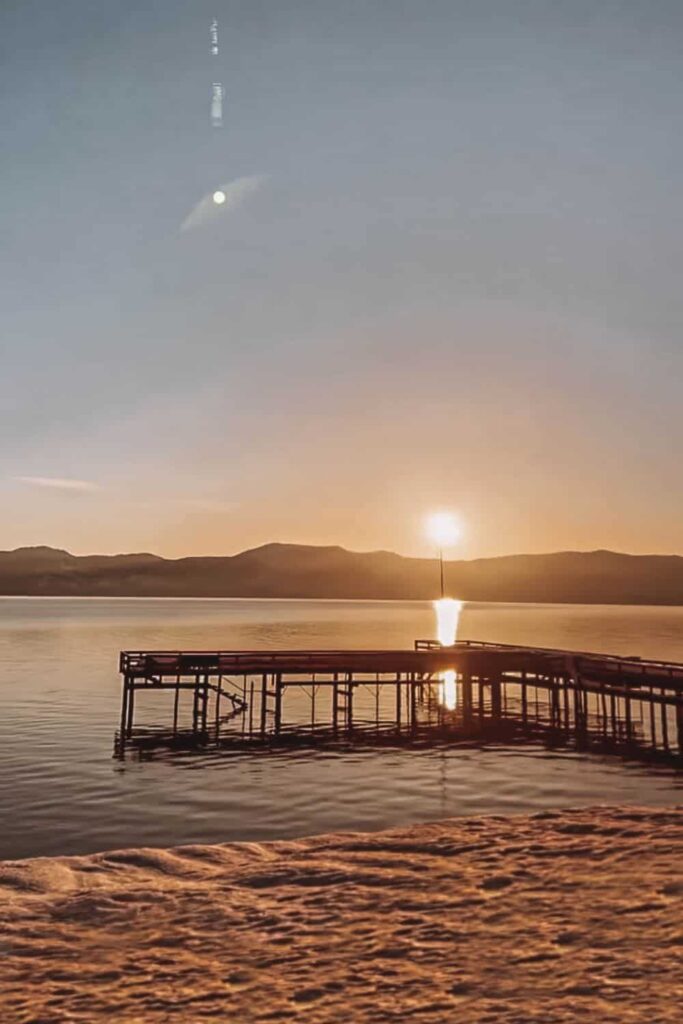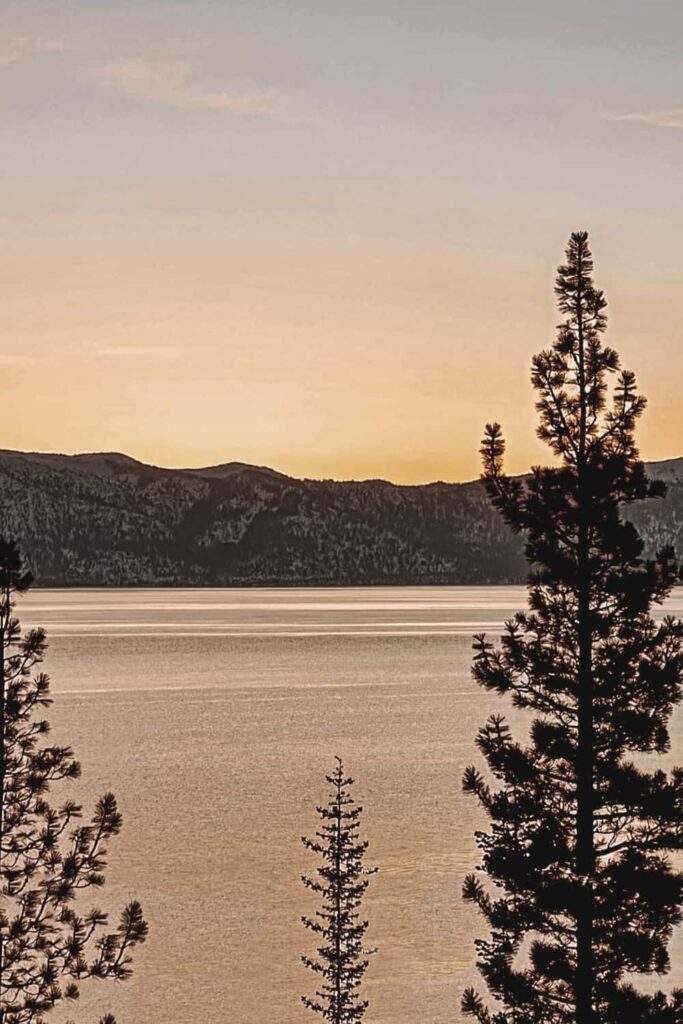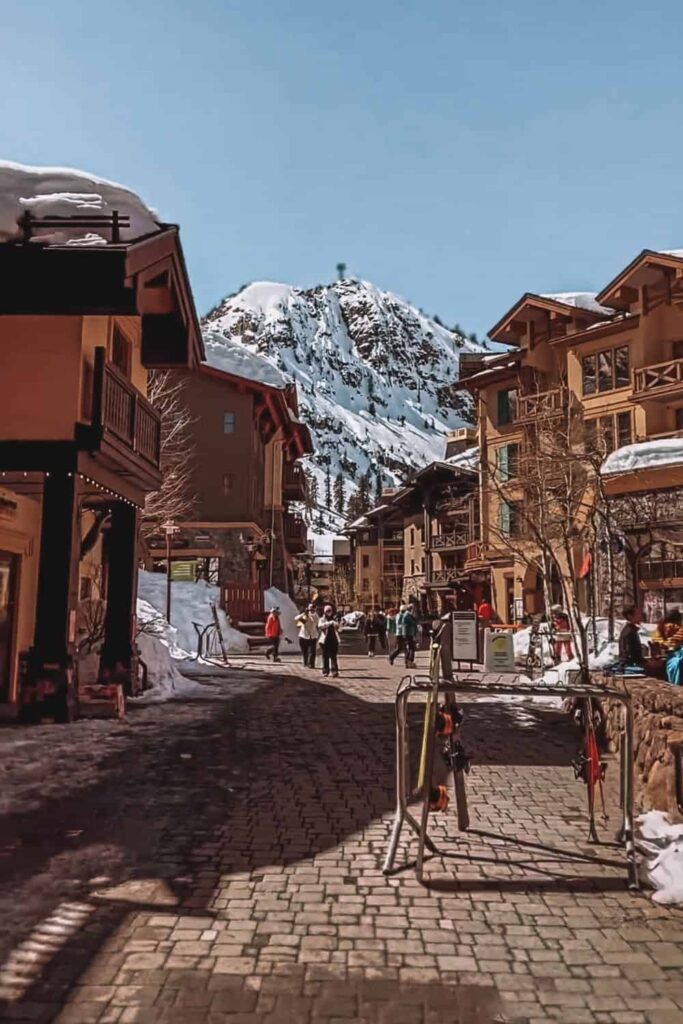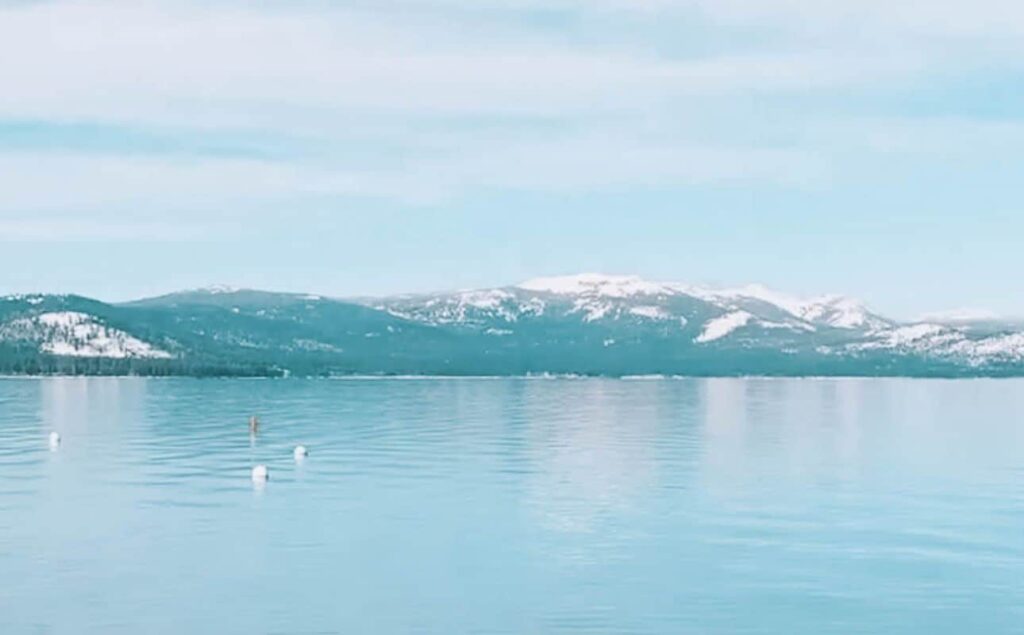Is Lake Tahoe Man Made? Yes and No! (+ 42 Lake Tahoe Fun Facts)
Is Lake Tahoe man made or natural? If you’re wondering that, we’ve got you covered! Considering the lake plays a major role in the USA, it’s fair to wonder whether this majestic area came to be on its own or if men have something to do with it.
So, is Lake Tahoe a natural lake or man made? Lake Tahoe is natural! Actually, most of Lake Tahoe was naturally formed but not all of it which we will explain in this post.
We absolutely love California and Lake Tahoe is a big part of the Golden State! From doing once in a lifetime activities in Los Angeles to dating in Santa Barbara and taking romantic sunset cruises, we love exploring California! Lake Tahoe is no exception! From Lake Tahoe’s impressive altitude to the natural hot springs it offers, it’s a dream destination for couples.
In this post, we go over everything you need to know about how Lake Tahoe was formed from whether it was a volcano to how deep it is and scary facts about Lake Tahoe!
***Some of the links in this post are affiliate links meaning we earn a small commission at no extra cost to you. This does not change the fact that we only recommend products, stays, activities and attractions we are satisfied with and all opinions expressed here are our own


Is Lake Tahoe man made?
Was Lake Tahoe man made? No!
Lake Tahoe, with its captivating natural beauty, was not man-made, but formed naturally over a period of 3 to 4 million years. The processes of faulting, volcanic activity, and glaciation contributed to the lake’s formation, giving it the awe-inspiring landscape we appreciate today. However, it’s worth noting that while the lake itself is a natural wonder, a dam located in Tahoe City is indeed man-made. This dam, controlled by the federal water master, creates a reservoir.
So, is Lake Tahoe a man made lake? No
But is Lake Tahoe Reservoir man made? yes.
Is South Lake Tahoe man made?
Similar to the rest of the lake, South Lake Tahoe is also naturally formed. It’s part of the same geologic processes that have shaped the entire lake over millions of years.
So, is Lake Tahoe man made or natural in the south? It is natural.
How was Lake Tahoe formed?
How did Lake Tahoe form? The story of Lake Tahoe’s formation begins around 25 million years ago with the formation of the Sierra Nevada block through uplifting. This activity led to the creation of two principal faults, with the eastern margin forming the Carson Range and the western side developing into the Sierra Nevada. This geological activity formed a valley that sank between these two parallel faults while the mountains on each side rose, creating what we now know as the Tahoe Basin. Water then filled this Basin, forming Lake Tahoe and the land we now know.
How water contributed to Lake Tahoe formation
Adding to the narrative of Lake Tahoe’s formation is the crucial role of water. Lava from Mt. Pluto, located on the lake’s north shore, created a natural barrier or dam across the basin. As water from rivers, streams, and snowfall flowed into the basin, it filled to become the famous public Lake of Tahoe. Over time, a new outlet eroded from the lava dam, forming the current path of the Lower Truckee River.
During the ice age, glaciation further sculpted the landscape, transforming V-shaped canyons on the west side of Lake Tahoe into U-shaped ones, leading to the creation of majestic waterfalls. We recommend visiting these natural wonders, as they offer a beautiful testament to the geologic Lake Tahoe history and natural evolution of the area.

Is Lake Tahoe a volcano?
No, Lake Tahoe is not a volcano.
The formation of Lake Tahoe is often understood as coming from a volcano but it’s not exactly what happened. How Lake Tahoe was formed wasn’t by the collapse of a volcanic crater, but rather through a different geologic process – faulting. The rise and fall of mountains due to this process led to the creation of the magnificent lake. Lake Tahoe geology is a testament to the power and beauty of natural geological processes.
When was Lake Tahoe discovered?
The discovery of Lake Tahoe by non-indigenous people can be traced back to 1844 when General John C. Fremont’s exploration party first documented it. However, it’s worth noting that Lake Tahoe is one of the oldest lakes, predating its 1844 “discovery” by millions of years.
What is Tahoe’s human history?
Lake Tahoe’s human history stretches back thousands of years, with the region initially occupied by Native American tribes. Artifacts reveal the presence of the Washoe Tribe of Native Americans in the area over 10,000 years ago. The Washoe Tribe referred to Lake Tahoe as “Da’aw”, translating to “the lake”. They considered it sacred life-sustaining water, and it held a central place in their world. The tribe camped, hunted, and fished at Lake Tahoe, living in harmony with the landscape for millennia.
In 1859, the discovery of the Comstock Lode in Virginia City, Nevada, marked a turning point in the region’s history. The 1860s saw Tahoe becoming a hub of commerce due to silver mines in Virginia City and the development of the Central Pacific Railroad. This period led to large-scale deforestation of the Tahoe Basin, as timber was used extensively to build mine shafts. Over 80 percent of the forests were cut down during this time.
Conservation efforts started gaining momentum during the 1912, 1913, and 1918 congressional sessions, focusing on protecting the Tahoe Basin. Later, in 1957, the League to Save Lake Tahoe was founded, furthering these efforts. Today, we recommend visitors like you and your partner to appreciate the rich history and natural beauty of Lake Tahoe while respecting the preservation work that goes into maintaining its pristine condition.
Why Lake Tahoe is so deep?
Lake Tahoe’s impressive depth is a result of geological processes, primarily faulting. The lake plunges to a maximum depth of 1,645 feet, or 501 meters, a dimension so substantial that it could completely submerge the Empire State Building, which stands at a height of 1,454 feet.
Is Lake Tahoe the deepest lake in the world?
While Lake Tahoe is not the deepest lake in the world, it certainly ranks among the deepest. In North America, there are only two deeper lakes: Crater Lake in Oregon, with a depth of 1,945 feet or 593 meters, and Canada’s Great Slave Lake, which reaches a depth of 2,015 feet or 614 meters. Globally, the deepest, largest, and oldest lake is Lake Baikal in Siberia, which dives to an astounding 5,400 feet, or 1,637 meters.
Where is Lake Tahoe?
Lake Tahoe is a remarkable natural landmark. Lake Tahoe location is at 39 degrees North latitude and 120 degrees West longitude.
Why is Lake Tahoe important?
Lake Tahoe is of immense importance due to numerous reasons. It is the largest freshwater lake in the Sierra Nevada and the largest alpine lake in North America. The five Great Lakes are the only lakes larger than Tahoe by volume, making it the second deepest lake in the United States, following Crater Lake in Oregon.
Tahoe was sacred to the Washoe Tribe, holding cultural significance that continues to resonate today. Moreover, the lake is vulnerable to wildfires, making its preservation and management crucial. As a scenic and ecological treasure, and even though it’s not a National Park, it’s one of the most important recreational resources in the United States, recognized nationally and globally as a resource of special significance. Its proximity to larger cities like Carson City and Tahoe City make it an attractive destination.
Given its outstanding natural value, Lake Tahoe has been designated an “Outstanding National Resource Water” under the Clean Water Act.
We recommend that you and your partner take the opportunity to explore Lake Tahoe’s natural beauty, whilst respecting its ecological importance and cultural heritage.
Is Lake Tahoe romantic and a good destination for couples?
Yes! Lake Tahoe is absolutely gorgeous and we recommend it as a romantic destination! Actually, if you decide to road trip the west coast with your partner, we recommend trying to include Lake Tahoe in your itinerary.
Lake Tahoe is beautiful all year-round. For example, in the winter, it’s perfect to go skiing, spend time at a romantic chalet or exploring natural hot springs together similarly to the romantic hot springs of Stanley Idaho. We love going to natural hot springs, it’s one of our favourite spa-like date ideas for couples!
During spring, the weather can be very different one year to another but it’s a great time to visit Tahoe as well. Between snow and wildflowers, you can do a lot during that time!
During summer, romantic activities would include hiking romantically around the lake, going to the beach, and enjoying water activities. Going to the beach with your partner is actually one of our favourite morning and day time date ideas and Tahoe is perfect for this.
All together, Lake Tahoe has lots to offer for everybody and the scenery makes it one of the most romantic places in the USA for sure! Don’t forget to take photos together and use our romantic couple travel captions to share with your friends and family.

Fun Tahoe Facts and Information on Lake Tahoe
Now that you know that Lake Tahoe is a naturally formed lake, we thought we’d include some scary facts about Lake Tahoe that will make you think twice before diving in!
1. Why is Lake Tahoe so dangerous?
Despite its beauty, Lake Tahoe carries certain dangers that visitors should be aware of. Its impressive depth, which adds to its allure, can also contribute to dangers such as water ski accidents and potential drownings. Black bears inhabit the area, and while usually not a threat if left undisturbed, it’s important to be aware of their presence.
The lake’s water can be dangerously cold, posing a risk to swimmers. Cold water shock can be fatal, so we recommend you and your partner exercise caution when swimming. Ensuring safety while enjoying the lake’s natural wonders is paramount.
2. Lake Tahoe length
Stretching from the northeast corner to the southwest corner, Lake Tahoe boasts a maximum length of about 22 miles, or 35 kilometers. This expansive length contributes to the lake’s grandeur and its diverse array of recreational opportunities.
3. Lake Tahoe can submerge the Empire State Building
In a striking comparison, Lake Tahoe, with its depth of 1,645 feet, could completely submerge the Empire State Building, which stands at a height of 1,454 feet. This depth is a testament to the profound geological processes that have shaped the lake over millions of years.
4. Lake Tahoe never completely freezes
Despite its cold temperatures, Lake Tahoe never completely freezes. Its significant depth prevents the lake from freezing in its entirety, although the surface can occasionally freeze during particularly cold winters.
5. There are 23 Ski Areas in Lake Tahoe
Lake Tahoe boasts 23 ski areas, including 12 downhill resorts with 700 ski runs and 11 nordic ski areas with 480 miles of trails. But there’s also a lot to do in Lake Tahoe for non-skiers. You and your partner can enjoy ice skating, sledding, visiting Tahoe’s natural hot springs, winter hiking, and snowshoeing. However, please be aware that Tahoe’s high elevation can require some adjustment.
6. Lake Tahoe area
Lake Tahoe spans five counties and encompasses one city, numerous communities, many beaches, and a host of natural hot springs. Its expansive area offers a diverse range of environments and experiences for visitors.
7. Over 2 states
To the question, ‘Lake Tahoe where is it?’, the answer is over two states! Lake Tahoe is unique in that it straddles two states, California and Nevada, each offering its own unique perspectives of the lake.
8. Lake Tahoe streams
Lake Tahoe’s waters are fed by 63 streams, but only one, the Truckee River, flows out from it. This unique hydrological feature further emphasizes Lake Tahoe’s distinctive natural characteristics.
9. Tahoe water timing
Water entering Lake Tahoe today takes approximately 650 years to reach the lake’s outlet, a fact that highlights the significant water volume the lake holds.
10. Water at Lake Tahoe evaporates
While the Truckee River drains about a third of Tahoe’s water, most of the lake’s water actually evaporates – about 330 million gallons per day. This is enough to supply approximately 3,900,000 households, emphasizing the significant role Lake Tahoe plays in the region’s hydrology.
11. The 1960 Winter Olympics made Lake Tahoe famous
Lake Tahoe first gained popularity as a summer destination in the 1920s, but it wasn’t until 1949 that winter skiing started. However, it was the 1960 Winter Olympics that catapulted Lake Tahoe into the limelight as a winter destination. So, whether you and your partner are sun worshippers or snow lovers, Lake Tahoe has something for everyone.
12. Size of Lake Tahoe
How big is Lake Tahoe? Lake Tahoe impresses with its considerable size. Its maximum width is approximately 12 miles or 19 kilometers, making it a grand spectacle of natural beauty.
13. Lake Tahoe is over a mile high
Perched at an altitude of 6,225 feet, Lake Tahoe sits high above sea level, with surrounding mountain peaks reaching nearly 11,000 feet. This elevation can make some visitors feel unwell, so we recommend taking necessary precautions when visiting.
14. How large is Lake Tahoe?
What does the volume of Lake Tahoe equate to? Lake Tahoe’s massive volume is hard to fathom, with its daily evaporation equating to the daily water needs of almost 4 million households. This immense body of water is both a vital resource and a captivating marvel of nature.
15. Lake Tahoe is over 2 million years old
When was Lake Tahoe made? Lake Tahoe is ancient, being over 2 million years old. This makes it older than most other lakes in the world, adding an extra layer of historical and geological significance to its beauty.
16. How much shoreline does Lake Tahoe have?
Lake Tahoe boasts approximately 75 miles or 120 kilometers of shoreline, although this can vary based on the lake level. With so much to explore, you and your partner may find it challenging to cover it all in one day.
17. Estimated 17 Million Trees in the Basin
The Lake Tahoe Basin is richly adorned with approximately 17 million trees, making it a haven for nature lovers. Predominantly populated by Jeffrey pines, the area also features lodgepole pine, sugar pine, incense cedar, and white and red fir.
18. 15 Million Visitors a Year at Lake Tahoe
While the Tahoe Basin only has around 55,000 year-round residents, it welcomes an astounding 15 million visitors each year. Open year-round, Lake Tahoe serves as both a summer and winter destination.
19. How deep is Lake Tahoe?
Lake Tahoe’s maximum depth is an impressive 1,645 feet or 501 meters, and it has an average depth of approximately 1,000 feet or 305 meters. This depth contributes to the lake’s awe-inspiring character.
20. Lake Tahoe fishing
Lake Tahoe offers numerous fishing opportunities, making it a paradise for anglers. With a variety of fish species inhabiting the lake, it promises exciting adventures for fishing enthusiasts.
21. Previous names of Lake Tahoe
When was ‘Lake Tahoe’ invented? Lake Tahoe has been called by numerous names throughout history. Captain Fremont referred to it as Bonpland in 1844, while his cartographer named it Mountain Lake. Other maps labeled it as Maheon and Big Truckee Lake. By 1853, it was being called Bigler, followed by an effort to re-label it Tua Tulia. In 1862, Henry DeGroot suggested Ta-hoe, an anglicization of the Washoe term da ow a ga. This last name, Tahoe, was officially adopted in 1945, and the lake has been known by this name ever since.
22. How is Lake Tahoe so pure? How does the clarity of Lake Tahoe compare to other lakes?
Lake Tahoe’s purity is quite remarkable. There’s no other lake in the world with an annual clarity surpassing that of Tahoe. Its water has been tested as 99.994% pure, which is even cleaner than distilled water. As a result, it’s not required to be filtered, emphasizing its pristine state.
23. Why is the Lake so blue?
Lake Tahoe’s iconic blue hue results from a combination of factors, including the reflection of the sky. Additionally, the lake’s clear water absorbs red light, leaving the rich, mesmerizing blue color that visitors like you and your partner come to see.
24. The Washoe Native Americans were here first
Long before any non-indigenous explorers arrived, Lake Tahoe was home to the Washoe Tribe of Native Americans for thousands of years. They considered the area sacred, particularly as summering grounds. The tribe is still active today in California and Nevada, maintaining their cultural ties to the region.
25. Lake Tahoe wildlife, flora and fauna
The Lake Tahoe area is rich in wildlife, with species such as the bear, northern goshawk, yellow-bellied marmot, mountain yellow-legged frog, pika, and snow plant. It’s also home to the sugar pine, willow flycatcher, and the kokanee salmon, making it a diverse ecological haven.
26. What is the surface area of Lake Tahoe?
Lake Tahoe has a substantial surface area of about 191 square miles, or 495 square kilometers, providing ample room for a variety of water activities.
27. What is the size of the Tahoe Watershed?
The Tahoe Watershed, or Lake Tahoe Basin, spans an area of 312 square miles or 800 square kilometers. This watershed plays a crucial role in sustaining the lake’s water levels and overall health.
28. The Pony Express
For 18 months, starting in April 1860, the Pony Express trail ran through southern Lake Tahoe and along Highway 50. This mail service dramatically cut delivery times from one to three months down to 10 days. However, it was discontinued when the Transcontinental Telegraph was completed in 1861.
29. Is Lake Tahoe water drinkable?
Yes, Lake Tahoe’s water is drinkable. Being one of the largest freshwater lakes in the world, its water is 99.994 percent pure, making it safe to drink.
30. How much water is actually in Lake Tahoe?
Lake Tahoe holds an impressive volume of about 39 trillion gallons of water, a testament to its vast size and depth.
31. What is its elevation?
Lake Tahoe sits at an elevation of 6,223 feet above sea level, making it the highest lake of its size in the United States. The lake’s elevation is controlled by a dam at Tahoe City. However, due to climate change, less water is flowing through the Truckee River, affecting the lake’s water levels.
32. The deadly Donner Pass
Donner Pass, located near Lake Tahoe, has a notorious history. It’s a challenging route to navigate, and many pioneers tragically lost their lives trying to traverse it in wagon trains. In 1846, 87 people tried to make the pass, resulting in 42 deaths due to harsh winter conditions. Even today, Donner Pass remains tricky to navigate.
33. What is at the bottom of Lake Tahoe?
The bottom of Lake Tahoe is shrouded in mystery and speculation. Legends circulate about dead bodies and shipwrecks lying at the lake’s depths, and fishermen have reported seeing corpses. Despite the chilling stories, the only certainty is that there’s a significant amount of trash at the bottom. Additionally, the nearby Fallen Leaf Lake is home to an ancient underwater forest. Since 2018, a maritime heritage underwater trail has been showcasing Lake Tahoe’s historic recreational watercraft and barges, submerged in Emerald Bay.
34. Lake Tahoe has a pet elephant
Yes, you read that correctly. Lake Tahoe was once the home of a 600-pound Sumatran elephant named Mingo. The pet of George Whittell, a wealthy resident of the Thunderbird Lodge, Mingo had a special elephant pen built by Whittell. Rumors also suggest that Whittell may have had a lion!
35. Does the Lake ever freeze over?
Lake Tahoe never completely freezes over. While the surface can develop a layer of ice, particularly in Emerald Bay, the entirety of the lake never solidifies. So, don’t worry about packing your ice skates on your next visit.
36. Lake Tahoe’s National Forest & State Parks
Over 90% of the Lake Tahoe area is managed by the US Forest Service and State Agencies, boasting 11 state parks in the region. These protected lands provide a sanctuary for local wildlife and a plethora of outdoor recreational activities for visitors like you and your partner.
37. How much algae is in Lake Tahoe?
Lake Tahoe contains a substantial amount of algae, with an estimated total of around 30 million trillion individual organisms. This aquatic plant life contributes to the lake’s vibrant and dynamic ecosystem.
38. How cold is the water?
Lake Tahoe’s water maintains a steady 39 degrees Fahrenheit below 600 feet. In the shallower areas, the water can reach up to 60 degrees Fahrenheit and above during the Tahoe spring and summer seasons.
39. Movies featuring Lake Tahoe
Lake Tahoe’s breathtaking landscapes have served as the backdrop for numerous movies. The Fleur de Lac estate was featured in the 1974 film The Godfather Part II. The Lake Tahoe Airport and Twin Peaks appeared in Top Gun: Maverick in 2022. Scenes from Into the Wild in 2007 were shot by Lake Tahoe and on the Pacific Crest Trail. The Bodyguard used Tallac House, a rustic lodge-style retreat on the shore of Fallen Leaf Lake, as a filming location.
40. Are there sharks in Lake Tahoe?
Rest assured, there are no sharks in Lake Tahoe. Sharks typically require saltwater environments, and Lake Tahoe is a freshwater lake.
41. Thunderbird Lodge and its secret tunnel
The opulent Thunderbird Lodge was funded by millionaire George Whittell, Jr. in 1936. The property includes a lush array of features such as a caretaker’s cottage, an elephant barn for Whittell’s pet elephant Mungo, and a secret tunnel leading to the boathouse. There are even rumors of a hidden dungeon and opium den, adding an air of mystery to this historic property.
42. Pennies-made bear sculpture
A bear sculpture named Ursa Mater can be found in Tahoe City’s Heritage Square on the North Shore. This unique piece of art is made from 200,000 American and Canadian pennies, totaling $2,000 in currency. If you and your partner enjoy art and culture, we recommend checking out this unique sculpture.
Final thoughts: Is Lake Tahoe man made?
As you can see, tot he question ‘is Lake Tahoe man made’, the answer is no! But part of the Lake, called the reservoir, was created because of the dam, which is man made! So men didn’t completely stay out of Lake Tahoe’s formation as we know it.
This beautiful lake serves many purposes from providing fresh water to locals to welcoming millions of visitors every year for fun and romantic stays away from home. We highly recommend visiting Lake Tahoe as it’s truly a natural wonder!
Any questions on Lake Tahoe’s formation ? Drop them in the comments or on insta @twolostexplorers and we will get back to you asap.
— SAVE THIS POST —
Did you like this post? If you liked this post, don’t hesitate to share it!
Want to save this post? You can pin the following images on pinterest to save this post.
We are Mary and Eric, the founders of Be Right Back, a blog dedicated to romance around the globe and at home.
We are Mary and Eric, the founders of Be Right Back, a blog dedicated to romance around the globe and at home. With over 10 years of experience in dating and traveling to romantic places, we share our favorite date ideas and romantic destinations to help couples level up their relationships. Having lived in and traveled through the USA, we also share our favourite things to do in the States.
With 70,000 monthly readers and 16,000 followers on social media, Be Right Back is your go-to resource for romantic trip ideas and couple activities at home and abroad.
